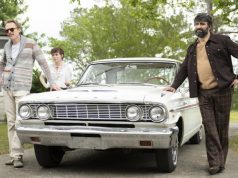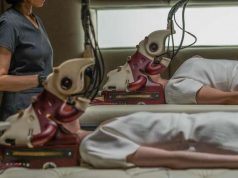The problem with making movies in the “grindhouse” style is that true grindhouse movies, almost by definition, were not seen by very many people. The target audience for a loving homage to the genre is therefore limited. Quentin Tarantino might adore the shlocky, violent capers of the 1970s, but how many of the rest of us have even seen them, much less love them enough to enjoy a re-creation of them?
“Hell Ride,” which Tarantino executive produced and Larry Bishop wrote and directed, is a salute to the ridiculous biker movies that Bishop frequently acted in back in the late ‘60s and early ‘70s. With titles like “The Savage Seven” and “Chrome and Hot Leather,” these were pure grindhouse cheese, and “Hell Ride” is either a parody of them or an adoring tribute. The line is always fine when it comes to a Tarantino project — does he really like these movies, or does he only like them ironically? — and here it’s nearly invisible.
Bishop stars as Pistolero, the leader of a motorcycle gang called the Victors. Fellow members include Comanche (Eric Balfour) and The Gent (Michael Madsen); a comrade named St. Louie has just been murdered by a rival gang, the 666ers, led by Billy Wings (Vinnie Jones) and The Deuce (David Carradine). The Victors want revenge for this, but the often incomprehensible plot has them searching for a buried treasure, too, planted by a woman named Cherokee Kisum before she was killed back in 1976. Adding to the general mayhem is the reappearance of Eddie Zero (Dennis Hopper), a first-generation Victor who was presumed dead but has now returned to offer guidance to his successors.
The sex and nudity are abundant and cheerfully gratuitous and include a naked oil-wrestling scene. Bishop has made sure to give himself the role that involves cavorting with beautiful nude women as often as possible. He also ratchets up the violence the way grindhouse fans (presumably) want it. Excess can be fun, of course, though it’s always better when it’s in the service of a story that’s actually going somewhere.
The screenplay’s tone is sometimes self-aware, as when a man shot with an arrow in the middle of the desert declares the hopeless situation to be “a nihilist’s dream come true.” One scene has two characters exchanging a lengthy chunk of dialogue full of plays on the word “fire,” and it goes on for so long that it’s either funny or annoying. But other scenes are just flat and dull, the very picture of rushed, uninspired filmmaking.
All of that, plus the uniformly over-cooked acting, makes it hard to tell what Bishop’s attitude is. We don’t know whether to laugh with the movie or at it, and that’s an uncomfortable feeling. A lot of the film is bad, maybe intentionally and maybe not. (Bishop’s previous writing/directing effort, 1996’s Mad Dog Time, aka Trigger Happy, certainly does not inspire a lot of confidence concerning his creative abilities.) But even if it’s bad on purpose — well, that’s not much of a consolation. I get tired of forced cleverness and genre deconstructions, and I have little patience for films whose lousiness is their selling point. If you can do a good job of making a bad movie, why not go the extra mile and make a good one?
C- (1 hr., 23 min.; )





